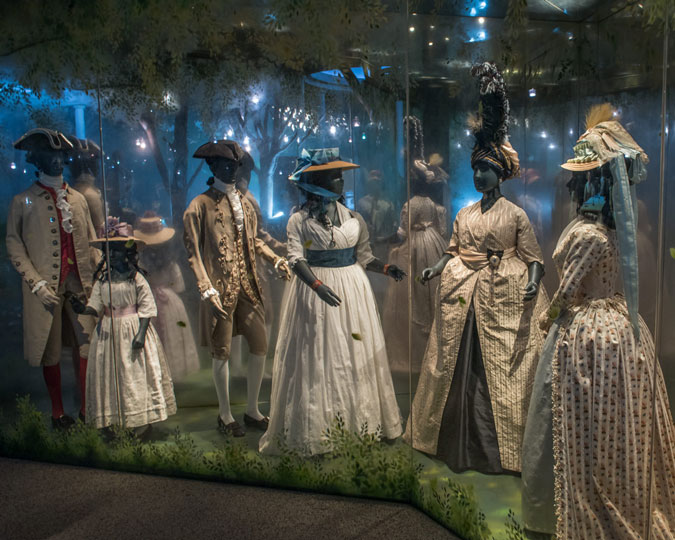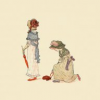minyoo
Assistant executioner
New Life
As exhausted as Mary and Jean were, they fell asleep quickly and didn’t stir until the dim light of morning came through the one small grimy window.
Sleep and morning did make things seem slightly less hopeless. A modest breakfast of some stale bread, spread with lard and washed down with Ann’s thin tea, was a welcome repast for the hungry little family.
After breakfast, Ann got to her sewing and offered to watch Jean while Mary had a chance to explore her new neighborhood. Stepping outside, Mary was struck at how dark the tenement alley was, even in daylight. Narrow and dirty, it wound north from Thames Street. Mary followed it north to Knightsbridge Street and on to Great Carter Lane and beyond again saw the imposing edifice of St. Paul’s Cathedral’s dome and twin spires.
Turning back south, she went down Peter’s Hill past the imposing Herald’s Office (founded in 1484 by Richard III) and eventually found her way to Thames Street, a rather prosperous thoroughfare with much traffic and many shops. One look at a price in a window taught Mary that she wouldn’t be shopping there.
To her surprise, two well-dressed young men came up to her and asked if they could rub her belly, “for luck.” Mary blushed deeply and demurred. This just encouraged the fops further as they asked would she take a “gratuity” for it. Recalling what Ann had said, Mary shyly asked, “A sixpence, Sirs?” The two instantly gave her three pennies each and proceeded to rub all over her round belly, gently, but very sensuously. After a while they thanked her and walked off, laughing.
Mary had begun her new occupation of making money in the streets.
Elated at her good fortune, Mary daringly stopped in a pub and purchased two suppers of bread, cheese, and beer for Ann and her for five-pence. She proudly took her contribution to the flat and told Ann what had happened and gave her the extra penny.
“Lord, yer the big spender, ain’tcha,” said Ann. “next time girl, bring all the copper back and we’ll pool for food and rent and such.”
“Yah, I knows,” replied Mary with a smile, cuddling with Jean. “Just this once’t I wanted a celebration and to thank my friend for taking us in.”
Ann hugged her and they sat down to eat the generous meal.
So, Mary’s life fell into a new pattern. She went out in the morning to the high street to try to get money. Ann warned her against begging which would brand her as a vagrant. Since she was not disabled (pregnancy wasn’t a disability like being lame or not having use of an arm), if she openly begged, she might be arrested as able-bodied poor to be sent to a workhouse or worse, judged idle poor or vagrant and sent to a house of correction. In either case she would be separated from Jean. It was a culture in which gender, age, and disability played crucial roles in the creation of a compelling case for relief. It was a culture in which location, accent, and time of year could determine whether a few pence were doled out, or the heavy hand of the law used to take up the supplicant as a vagrant to receive the brand “V”.
So, Mary learned to do the subtle dance of a beggar, looking downtrodden and hurt, giving passersby pitiful looks asking for mercy. She soon learned that the gentility who were her target, operated under similar, equally complex rules of engagement. For the bewigged and tutored, leisure, and fashion-conscious denizens of eighteenth-century London, the calls of pity had to be answered with just the right combination of sympathy and disdain, just the right flourish of lace and charity.
Unfortunately for our girl, her state of advanced pregnancy was not an inducement to charity on the part of many. A woman, alone on the street and with child was presumed a prostitute and whose fecundity was regarded by many as counterproductive for society.
Many days she came home, footsore and bedraggled with only a couple of farthings to show for her efforts. Other days, generous gentry might give her a total of a crown, or strange men might give a tanner to rub her belly. Several then offered more to rub other parts, but Mary always refused.
Though Ann was good to her, Mary clearly understood that she wasn’t keeping up her share of the costs. On those days when her takings were lowest, she’d supplement her meager haul with a few pence from the tiny savings she had brought with her. As March moved into April and then to May, she watched with trepidation this small hoard dwindling close to vanishing.
By the end of May, Mary couldn’t go beg anymore. She had to lie down most of the days, her legs swollen and her back aching. Late on June 6th, she went into labor.
Her delivery progressed slowly and her water only flowed late on the 7th. Ann was kind, but knew little to be of help.
At last, early on the morning of Saturday, June 9th, 1771, seventeen-year-old Mary Jones delivered a baby girl, remarkably healthy. She named her Abigail after Mary’s aunt. Her father had told her that the name meant “my father's joy.” She prayed that William would be home soon and find joy in his new daughter.
Farthing – one-fourth of a penny (original name “fourthing”)
For those looking for Ann’s neighborhood today, most is gone, first plowed under when Queen Victoria street was added as a continuation of Threadneedle street to cut through the neighborhood and later due to the blitz and urban renewal. Thames Street is mostly underground. Though the Herald’s Office, now called the College of Arms, remains, rather much altered with time.
A Dreadful Longing
For a couple of weeks after Abby was born, Mary rested at the flat and took care of her children. Two days after giving birth, Mary felt her milk coming and began nursing Abby. She was surprised at how much her breasts swelled and how full her milk supply was. Since puberty, Mary had always had large breasts for her thin frame, but now they seemed enormous. Ann kidded her about her “Apple-Dumpling Shop.”
After that couple of weeks, Mark’s feeling of guilt became overwhelming. Ann was working day and night to earn money to support the added in the flat. In addition to extra sewing, she seemed to be out every evening “playing” with her boyfriends. Mary knew she had to help.
On a Monday, when Abby was 16 days old, Mary took her babe in her arms and went out to beg. Now, the presence of a baby seemed slightly less offending to the morality of the passers-by. But her yield from simple charity was no more than a few pence most days with sometimes as much as a shilling and often nothing. It was better than nothing, but not enough to keep up her part of the expenses.
Needless to say, there were no offers to rub her belly for a tanner, but there was a lot of interest of the men in her large bosom. Many asked to rub them, but Mary steadfastly refused
By the end of June, Mary was becoming desperate. Ann had been incredibly patient, but she was now frequently mentioning that strain on her to support this “family I ne’er asked for.” And another concern was weighing heavily on Mary’s mind. On the 2nd of July she snuck a look at her little savings, wrapped up in a kerchief. 6 pence! She had to make more money!
The next morning, on Thames street when a handsome older gentleman politely asked if he could rub her bosom, “for luck,” Mary said “Yes Sir, for a tanner?” He gently stroked the large orbs for a moment and then gave her eightpence. Mary had, at the last limit of necessity, allowed herself to be touched sexually. She blushed deeply and thanked the gentleman, and then almost vomited.
Still reluctant to prostitute herself, Mary only occasionally acquiesced to the requests, and then only from gentle looking men and, to her surprise, a few nicely dressed women. The extra income caused Ann to complain less, though Mary still knew they were an unwelcome burden on her friend. With all the money she received, going to Ann, Mary also made no progress to relieve the really big worry on her mind.
On July 12th, Mary looked again at her tiny hoard, now 11 pence (she had snuck a penny or two in while feeling very guilt for Ann). She then looked at her two-month-old and gave a sob. She decided she could delay no longer.
The next day, Mary dressed with her stays loosened and her big breasts more prominent. She smiled fetchingly at all men, not just the good looking. When a man asked her about rubbing her breasts, she replied “a tanner for a rub, a tanner and three to rub the nips!”
Mary’s income rose, though not greatly. When men could mount a whore for anywhere from four Bob to Five Quid for a top model like Kitty Fisher, almost a shilling for touching some big tits was not an attractive offer. By early August, Mary had only collected a total of 26 pence in her hoard. That evening she broke down and told Ann of the fear that was gnawing at her heart.
Bob – a shilling, twelve pence.
Quid – A pound, 20 shillings
Rubbing the pregnant woman's belly seems like an odd, weird, yet somehow very much like what would have happened in the era.
Not to mention cute. Very cute.














 )
) -
-
 . I hear that was a hanging offence in London in those days!
. I hear that was a hanging offence in London in those days!